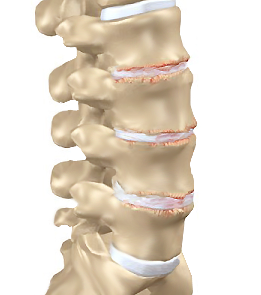What is Osteoarthritis of the Spine?

Osteoarthritis of the spine is also known as degenerative arthritis of the spine. Osteoarthritis is a breakdown of the cartilage of joints and discs in the neck and lower back.
Degenerative arthritis of the spine, sometimes, can produce bone spurs. These spurs put pressure on the nerves leaving the spinal column. When pressure is applied, weakness and pain in the arms or legs occur.
It’s normal for this disease to occur in the elderly. However, younger people may get it from injury or trauma to a joint or a genetic defect involving cartilage. For those who are younger than 45, osteoarthritis is more common among men. Over the age of 45, degenerative arthritis of the spine is more common among women. Furthermore, it’s also more common in those who are overweight and frequent repetitive stress movements.
Symptoms & Signs of Spinal Osteoarthritis:
The signs and symptoms of osteoarthritis include the following:
- Stiffness or pain in the neck or back
- Weakness or numbness in the arms or legs
- Severe cases can affect the spinal cord
Some people experience little to no symptoms or interference. On the other hand, others may become severely disabled.
Causes & Risk Factors:
Osteoarthritis occurs when the cartilage of the cushions on the end of the bones deteriorates over time. This disease is often referred to as “wear and tear” of the spine.
Risk factors include:
- Older age. The risk of degenerative arthritis of the spine increases with age.
- Sex. Women are more likely to develop osteoarthritis, though it isn’t clear why.
- Joint injuries. These injuries occur when playing sports or from an accident, which can increase the risk of osteoarthritis. However, past injuries that seemingly healed can also increase your risk of degenerative arthritis of the spine.
- Obesity. Carrying extra body weight contributes to osteoarthritis in several ways, and the more you weigh, the greater your risk.
- Repeated stress on the joint. If your job or a sport you play causes repetitive stress on a joint, that joint might eventually develop degenerative arthritis of the spine.
- Certain metabolic diseases. These include diabetes and a condition in which your body has too much iron (hemochromatosis).
- Genetics. Some people inherit a tendency to develop osteoarthritis.
- Bone deformities. Some people are born with malformed joints or defective cartilage.
Treatment for Osteoarthritis of the Spine:
However, osteoarthritis cannot be cured. Although treatments can help you live a better quality of life and manage pain. Medications are usually the first step in treating osteoarthritis.
Medications
Pain can be managed through medications when living with arthritis of the spine. These medications include the following:
- Acetaminophen. Acetaminophen (Tylenol, others) has been shown to help some people with osteoarthritis who have mild to moderate pain.
- Nonsteroidal anti-inflammatory drugs (NSAIDs). Over-the-counter NSAIDs, such as ibuprofen (Advil, Motrin IB, others) and naproxen sodium (Aleve, others), taken at the recommended doses, typically relieve osteoarthritis pain.
- NSAIDs can cause stomach upset, cardiovascular problems, bleeding problems, and liver and kidney damage. Gel NSAIDs applied to the skin over the affected joint have fewer side effects. And may also relieve pain just as well.
- Duloxetine (Cymbalta). Duloxetine is commonly used as an antidepressant. Furthermore, it is also approved to treat chronic pain, including osteoarthritis pain.
Therapy
Physical & occupational therapy is typically recommended for patients who have been diagnosed with osteoarthritis. Physical therapy can be effective through exercises to strengthen the muscles around the affected joint. On the other hand, occupational therapy can also be a great way to manage. Occupational therapy helps manage everyday tasks that have now become difficult with your condition.
Procedures & Surgical Options
When conservative methods aren’t helping relieve your pain, surgery & procedures might be recommended, such as:
- Cortisone injections. Sometimes injections of corticosteroid medications may relieve pain in your joint. During this procedure, your doctor numbs the area around your joint, then places a needle into space within your joint and injects medication.
- Lubrication injections. Injections of hyaluronic acid may offer pain relief by providing some cushioning in your knee. However, some research suggests that these injections will offer no more pain relief than a placebo. Hyaluronic acid is similar to a component and is found in your joint fluid.
- Realigning bones. If osteoarthritis has damaged one side of your knee more than the other, an osteotomy is often helpful. In a knee osteotomy, the surgeon cuts across the bone either above or below the knee. And then removes or adds a wedge of bone. Therefore, shifting your body weight away from the worn-out part of your knee.
- Joint replacement. In joint replacement surgery (arthroplasty), your surgeon removes your damaged joint surfaces and replaces them with plastic and metal parts. Surgical risks include infections and blood clots. Artificial joints can wear out or come loose and may need to eventually be replaced.
If you are experiencing sciatica pain without relief, call us today to visit a spine specialist near you at 888-409-8006. The offices are conveniently located in South Florida; Boca Raton, Deerfield Beach & Plantation.
